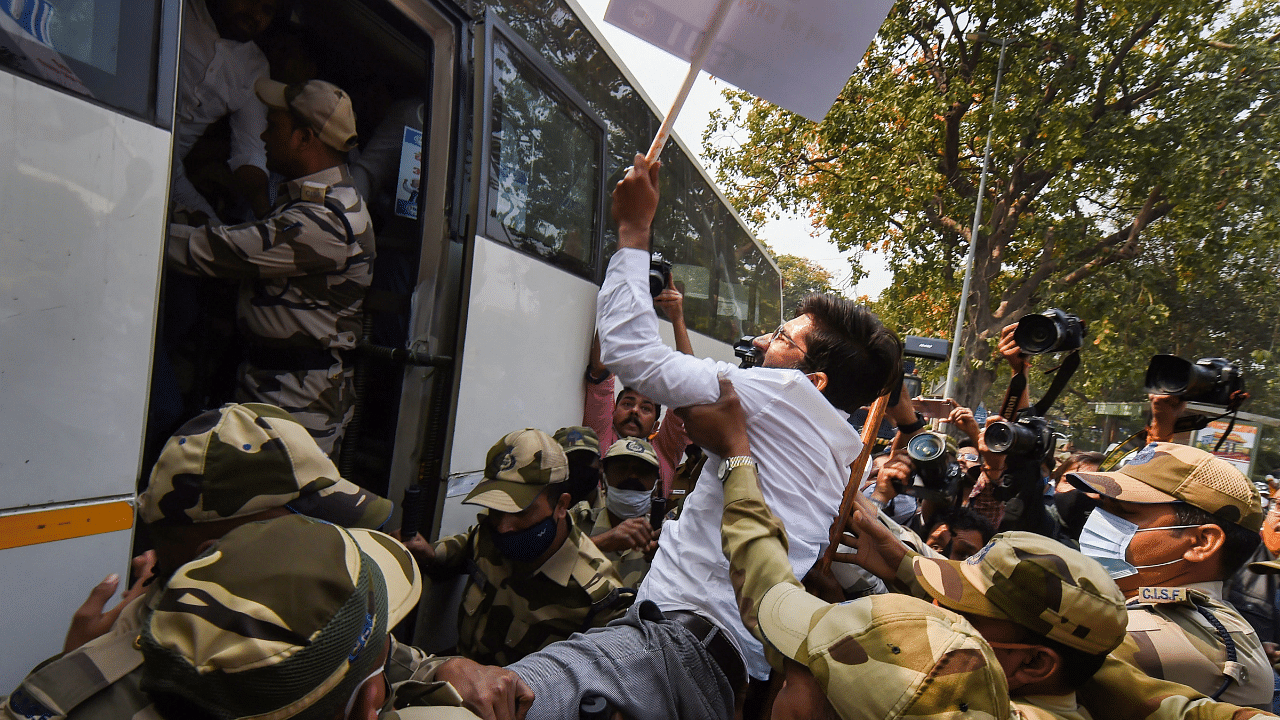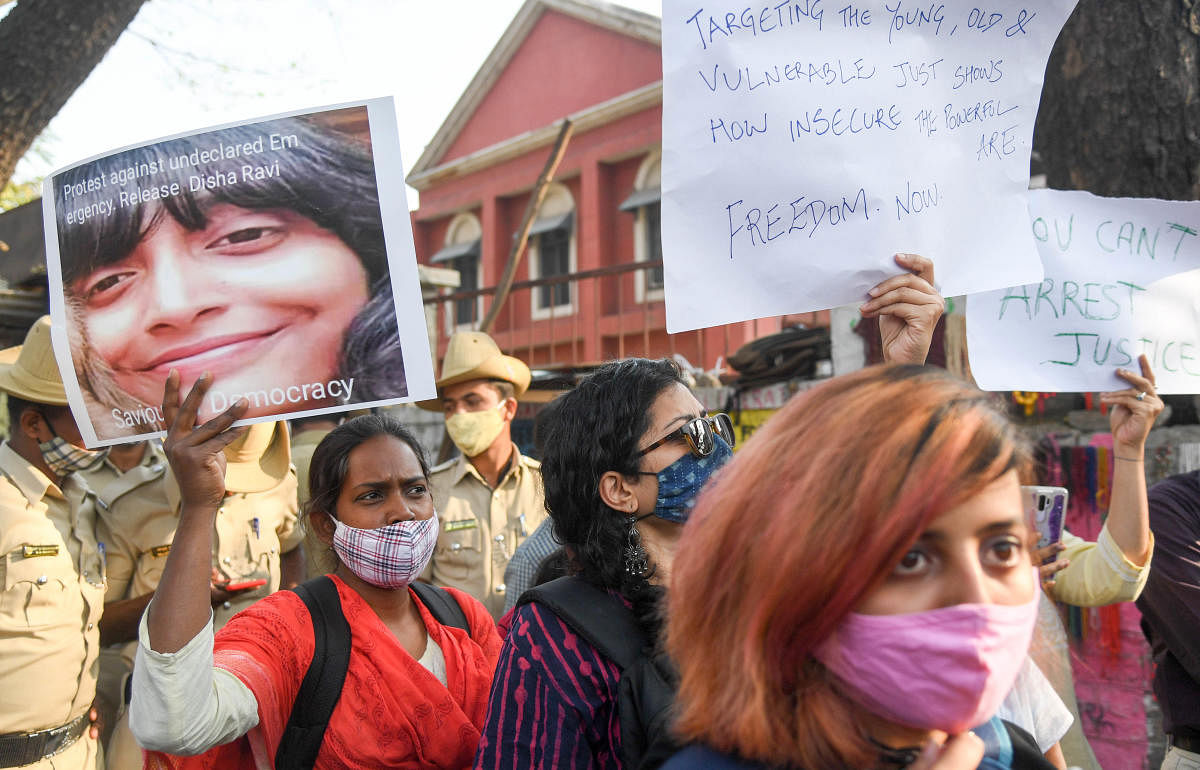

‘How dare you!’ — when Greta Thunberg thundered these words at the UN Climate Action Summit in New York in 2019, it was an attack against the biggest world leaders for ignoring the climate crisis. Today, in India, it appears these roles have been reversed.
It is the Narendra Modi-led government and the BJP asking 22-year-old climate activist Disha Ravi and other young people like her: ‘How dare you not sit with your head down and be good students?’ ‘How dare you not follow the narrative?’ ‘How dare you protest and talk politics?’ 'How dare you move beyond planting saplings and cleaning lakes, and criticise policies?' ‘How dare you stand with ‘them’ and not ‘us’?’
And this is the message for anyone else not toeing their line: How. Dare. You.
Authoritarian regimes are made uncomfortable by anybody who questions the status quo. They don’t just want to control people’s speech but dictate their thoughts as well.
“There are two kinds of attacks happening on young people. One is frontal, which is bluntly telling them to shut up and stay at home. The other is poisoning the mind of young people by what they are taught in school so they can’t think freely and come to their own conclusions of complex things,” said musician and activist T M Krishna at a recent press conference.
This is not the first time there has been a crackdown on dissent. But under the current regime, a narrative has been built where anybody who questions its authority is, in essence, questioning the integrity of the nation. Being against the government today is being against India. So, an arrest like Disha’s is part of a larger pattern to create an ecosystem of fear through a steady muzzling of young educated voices, believe researchers, teachers and student leaders.
“The intention is to silence all criticism of the government and equate such criticism with the overthrow of the state and sedition. The only purpose is to terrorise everyone because not one of these cases will stand up in court,” says Nivedita Menon, a professor at the Centre for Comparative Politics & Political Theory at the Jawaharlal Nehru University (JNU), New Delhi.
It isn’t just activists that the government and its institutions have set their eyes on but anyone with a perspective that opposes the ruling party’s agenda. In the last two years, the casualties range from 19-year-old Amulya Leone, standup comic Munawar Faruqui whose unspoken joke became a ‘thought crime’, journalist Mandeep Punia, Dalit activists Nodeep Kaur and Shiv Kumar who were protesting against the farm laws.
Despite a very frontal attack against youth, the recent developments don’t seem to be driving them away from the BJP. They continue to remain its core and most loyal demographic, staunch in ideology and strong in numbers.
“There is a possibility that the youth haven’t recovered from the image trap the party laid. Modi is projected as the man who will build a New India, not to be confused with Modern India, for which, he has fashioned himself like a sage, a Bheeshma Pitamaha. Another is the creation of a section that sees enemies on the outside, not within — like Pakistan or Rahul or Mamata. These mythical images are being constantly constructed and reproduced to obfuscate real issues. So despite the pandemic, the migration, the price rise, youth continue to support the BJP,” says Prof Muzaffar Assadi, a political scientist.
Parents' dilemma
Arrests like these are a warning to parents as well.
While some parents are sympathetic to their children’s fight, driven by fear, they ask that children choose between family or the cause. Meanwhile, others approve as long as the issue is not political, policy-related or attacking the government. Fighting for civic or environmental issues, they believe, is less risky. But after the Disha Ravi case, even that illusion seems to have lifted.
There is also a section of teachers who feels that students jump into activism without really understanding the full extent of what they are up against. Educational institutions themselves are not too keen on having their names associated with activism and prefer to distance themselves from anything political.
“The government knows how to arm-twist the media, businesses and education institutions where it controls the funds and grants. Faculty stay quiet because there’s a lot at stake, including their livelihood. Colleges are also worried about their reputation and endangering other students,” says a lecturer.
Yes, young minds are impressionable, and this is why it becomes all the more important that parents and teachers guide students rather than admonish them and shy away from political discourse. Expressing shock at this trend, a group of more than 200 parents issued an open letter to the media.
“As parents, we know that all-round development of children and youth is only possible when they are exposed to different viewpoints when they can debate and stand for or against any position… We are dismayed at the exhortations to youth to “keep their heads down” and “focus on their studies", it read.
Due process as a punishment
What has helped the government push its skewed view of dissent is also the repeated misuse of Section 124A of IPC on sedition and the Unlawful Activities (Prevention) Act (UAPA), whereby dissenting voices standing up for their constitutional right are portrayed as traitors. “Instead of engaging in constructive dialogue with protesters, they are using sections of the law arbitrarily, causing a ‘chilling effect’,” says advocate Vinay K Sreenivasa.
“Under UAPA, no chargesheet is filed for six months. This long-drawn-out process itself becomes the punishment,” he adds.
A worrying development is also a perversion of the criminal justice system by the government to crush its opponent. For instance, Haryana Cabinet Minister Anil Vij, who openly called for Disha’s killing, or Kapil Mishra’s Hindu Ecosystem toolkit on Telegram, have seen no registering of an FIR, pointing to a selective application of the law.
If the state or its draconian laws don’t come for you, mainstream TV channels and right-wing trolls definitely will. Social media has become a powerful tool where words are peddled around with conspiracy theories, and people are branded anti-nationals, Urban Naxals and andolanjeevis.
The cost of dissent
There is, unfortunately, a cost of dissent. “I was in prison for a month, whereas these days people are in prison for years. Nobody is going to compensate for the time I lost in prison or the mental trauma my father suffered. Ultimately, we know what kind of hazard there is and we have accepted that as a new normal,” says Anirban Bhattacharya, a researcher and activist, who was arrested along with Kanhaiya Kumar and Umar Khalid for sedition during the 2016 JNU agitations.
The cost is even greater and more damaging for some than others. “The UAPA, and its predecessors like TADA and POTA, have always been used to quell dissent from marginalised groups,” says Shireen Azam, a researcher with Oxford University. Outspoken youth from Muslim or DBA (Dalit, Bahujan and Adivasi) communities are prime targets. Women, more so, face extreme vilification.
“When these arrests happen, they are sensationalised on television and print media... But there is very little reportage when they are proven innocent and acquitted years later, conveniently leading to a national impression that some groups commit more crimes,” says Shireen.
Gopi Swamy, the convener of Ambedkar Students’ Association at the University of Hyderabad, feels the impact is also hard on first-generation students. “My parents know that I’m the general secretary of the students' union but they don’t know that I have charges against me in connection with the anti-CAA protests. If they find out, they will ask me to stop my studies and return home immediately. But when you are socially boycotted and atrocities are committed against you, it’s impossible to remain silent,” he says.
And this is where the government seems to have lost its plot. Youngsters may be vulnerable but they are also fearless, critical and educated. To them, the memory of fear is very short-lived but the memory of resistance is longer. And in the long run, the ecosystem of fear will fail to sustain.
“Fear will percolate but only temporarily. Every time you push one down, a hundred others come up,” says Bhavya Narasimhamurthy, who was detained during the anti-CAA protests in Bengaluru.
Yet, the future of youth activism in India is not for the students to decide.
In a country where merely thinking is a crime, where the government is insecure and people are paranoid of each other, “We must continue to seek accountability from the state, and not get swayed by the narrative. We must continue to ask the questions raised by Disha, Amulya, Umar, Devangana, Safoora and Rohith Vemula. Whether the institution is functioning or not, we must not stop making demands of it,” says Vinay.